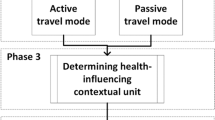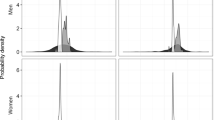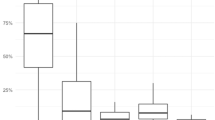Abstract
Tools to assess time-location patterns related to environmental exposures have expanded from reliance on time-location diaries (TLDs) and questionnaires to use of geospatial location devices such as data-logging Global Positioning System (GPS) equipment. The Multi-Ethnic Study of Atherosclerosis and Air Pollution obtained typical time-location patterns via questionnaire for 6424 adults in six US cities. At a later time (mean 4.6 years after questionnaire), a subset (n=128) participated in high-resolution data collection for specific 2-week periods resulting in concurrent GPS and detailed TLD data, which were aggregated to estimate time spent in various microenvironments. During these 2-week periods, participants were observed to spend the most time at home indoors (mean of 78%) and a small proportion of time in-vehicle (mean of 4%). Similar overall patterns were reported by these participants on the prior questionnaire (mean home indoors: 75%; mean in-vehicle: 4%). However, individual micro-environmental time estimates measured over specific 2-week periods were not highly correlated with an individual’s questionnaire report of typical behavior (Spearman’s ρ of 0.43 for home indoors and 0.39 for in-vehicle). Although questionnaire data about typical time-location patterns can inform interpretation of long-term epidemiological analyses and risk assessment, they may not reliably represent an individual’s short-term experience.
This is a preview of subscription content, access via your institution
Access options
Subscribe to this journal
Receive 6 print issues and online access
$259.00 per year
only $43.17 per issue
Buy this article
- Purchase on Springer Link
- Instant access to full article PDF
Prices may be subject to local taxes which are calculated during checkout

Similar content being viewed by others
References
Dockery DW, Pope CA, Xu X, Spengler JD, Ware JH, Fay ME et al. An association between air pollution and mortality in six U.S. cities. N Engl J Med 1993; 329: 1753–1759.
Miller KA, Siscovick DS, Sheppard L, Shepherd K, Sullivan JH, Anderson GL et al. Long-term exposure to air pollution and incidence of cardiovascular events in women. N Engl J Med 2007; 356: 447–458.
Pope CA, III, Burnett RT, Thun MJ, Calle EE, Krewski D, Thurston GD et al. Lung cancer, cardiopulmonary mortality, and long-term exposure to fine particulate air pollution. JAMA 2002; 287: 1132–1141.
Hoek G, Brunekreef B, Goldbohm S, Fischer P, Van Den Brandt PA . Association between mortality and indicators of traffic-related air pollution in the Netherlands: a cohort study. Lancet 2002; 360: 1203–1209.
Ostro B, Lipsett M, Reynolds P, Goldberg D, Hertz A, Garcia C et al. Long-term exposure to constituents of fine particulate air pollution and mortality: results from the California Teachers Study. Environ Health Perspect 2010; 118: 363–369.
Gehring U, Heinrich J, Kramer U, Grote V, Hochadel M, Sugiri D et al. Long-term exposure to ambient air pollution and cardiopulmonary mortality in women. Epidemiology 2006; 17: 545–551.
Rosenlund M, Berglind N, Pershagen G, Hallqvist J, Jonson T, Bellander T . Long-term exposure to urban air pollution and myocardial infarction. Epidemiology 2006; 17: 383–390.
Puett RC, Hart JE, Yanosky JD, Paciorek C, Schwartz J, Suh H et al. Chronic fine and coarse particulate exposure, mortality, and coronary heart disease in the Nurses’ Health Study. Environ Health Perspect 2009; 117: 1697–1701.
Nethery E, Mallach G, Rainham D, Goldberg MS, Wheeler AJ . Using Global Positioning Systems (GPS) and temperature data to generate time-activity classifications for estimating personal exposure in air monitoring studies: an automated method. Environ Health 2014; 13: 1–11.
Spalt EW, Curl CL, Allen RW, Cohen M, Williams K, Hirsch Ja et al. Factors influencing time-location patterns and their impact on estimates of exposure: the Multi-Ethnic Study of Atherosclerosis and Air Pollution (MESA Air). J Expo Sci Environ Epidemiol 2015; 26: 341–348.
Setton E, Marshall JD, Brauer M, Lundquist KR, Hystad P, Keller P et al. The impact of daily mobility on exposure to traffic-related air pollution and health effect estimates. J Expo Sci Environ Epidemiol 2011; 21: 42–48.
U.S EPA. Exposure factors handbook 2011 edition (final). EPA Report 2011. Report No.: EPA/600/R-09/052F.
U.S EPA Descriptive Statistics Tables from a Detailed Analysis of the National Human Activity Pattern Survey (NHAPS) Data. U.S. Environmental Protection Agency: Las Vegas, NV, USA. 1996.
Graham SE, McCurdy T . Developing meaningful cohorts for human exposure models. J Expo Anal Environ Epidemiol 2004; 14: 23–43.
Spalt EW, Curl CL, Allen RW, Cohen M, Adar SD, Stukovsky KH et al. Time–location patterns of a diverse population of older adults: the Multi-Ethnic Study of Atherosclerosis and Air Pollution (MESA Air). J Expo Sci Environ Epidemiol 2015; 26: 349–355.
Kaufman JD, Adar SD, Allen RW, Barr RG, Budoff MJ, Burke GL et al. Prospective study of particulate air pollution exposures, subclinical atherosclerosis, and clinical cardiovascular disease: the Multi-Ethnic Study of Atherosclerosis and Air Pollution (MESA Air). Am J Epidemiol 2012; 176: 825–837.
Cohen MA, Adar SD, Allen RW, Avol E, Curl CL, Gould T et al. Approach to estimating participant pollutant exposures in the Multi-Ethnic Study of Atherosclerosis and Air Pollution (MESA Air). Environ Sci Technol 2009; 43: 4687–4693.
Allen RW, Adar SD, Avol E, Cohen M, Curl CL, Larson T et al. Modeling the residential infiltration of outdoor PM2.5 in the multi-ethnic study of atherosclerosis and air pollution (MESA Air). Environ Health Perspect 2012; 120: 824–830.
Chan CC, Ozkaynak H, Spengler JD, Sheldon L . Driver exposure to volatile organic compounds, CO, ozone, and NO2 under different driving conditions. Environ Sci Technol 1991; 25: 964–972.
Jo WK, Park KH . Concentrations of volatile organic compounds in the passenger side and the back seat of automobiles. J Expo Anal Environ Epidemiol 1999; 9: 217–227.
Leung P-L, Harrison RM . Roadside and in-vehicle concentrations of monoaromatic hydrocarbons. Atmos Environ 1999; 33: 191–204.
Westerdahl D, Fruin S, Sax T, Fine PM, Sioutas C . Mobile platform measurements of ultrafine particles and associated pollutant concentrations on freeways and residential streets in Los Angeles. Atmos Environ 2005; 39: 3597–3610.
McCurdy T, Glen G, Smith L, Lakkadi Y . The national exposure research laboratory’s consolidated human activity database. J Expo Anal Environ Epidemiol 2000; 10: 566–578.
Kan MY, Pudney S . Measurement error in stylized and diary data on time use. Sociol Methodol 2008; 38: 101–132.
Blanchard RA, Myers AM, Porter MM . Correspondence between self-reported and objective measures of driving exposure and patterns in older drivers. Accid Anal Prev 2010; 42: 523–529.
Wu J, Jiang C, Jaimes G, Bartell S, Dang A, Baker D et al. Travel patterns during pregnancy: comparison between Global Positioning System (GPS) tracking and questionnaire data. Environ Heal 2013; 12: 1.
Kerr J, Duncan S, Schipperjin J . Using global positioning systems in health research: a practical approach to data collection and processing. Am J Prev Med 2011; 41: 532–540.
Mavoa S, Oliver M, Witten K, Badland HM . Linking GPS and travel diary data using sequence alignment in a study of children’s independent mobility. Int J Health Geogr 2011; 10: 64.
Wu J, Jiang C, Houston D, Baker D, Delfino R . Automated time activity classification based on global positioning system (GPS) tracking data. Environ Health 2011; 10: 101.
Kim T, Lee K, Yang W, Yu S . A new analytical method for the classification of time–location data obtained from the global positioning system (GPS). J Environ Monit 2012; 14: 2270.
Adams C, Riggs P, Volckens J . Development of a method for personal, spatiotemporal exposure assessment. J Environ Monit 2009; 11: 1331–1339.
Bild DE, Bluemke DA, Burke GL, Detrano R, Diez Roux AV, Folsom AR et al. Multi-ethnic study of atherosclerosis: objectives and design. Am J Epidemiol 2002; 156: 871–881.
ArcGIS Desktop. Release 10. Redlands, CA, USA.
R Core Team 2015 R: A language and environment for statistical computing. R Foundation for Statistical Computinghttp://www.r-project.org/.
Huss A, Beekhuizen J, Kromhout H, Vermeulen R . Using GPS-derived speed patterns for recognition of transport modes in adults. Int J Health Geogr 2014; 13: 40.
Breen MS, Long TC, Schultz BD, Crooks J, Breen M, Langstaff JE et al. GPS-based microenvironment tracker (MicroTrac) model to estimate time–location of individuals for air pollution exposure assessments: Model evaluation in central North Carolina. J Expo Sci Environ Epidemiol 2014; 24: 412–420.
Hu M, Li W, Li L, Houston D, Wu J . Refining time-activity classification of human subjects using the global positioning system. PLoS One 2016; 11: e0148875.
Acknowledgements
This publication was developed under U.S. EPA STAR research assistance agreement, No. RD831697 (MESA Air) and U.S. EPA grant RD-83479601-0 (CCAR). It has not been formally reviewed by the EPA. The views expressed in this document are solely those of the authors and the EPA does not endorse any products or commercial services mentioned in this publication.
Author information
Authors and Affiliations
Corresponding author
Ethics declarations
Competing interests
The authors declare no conflict of interest.
Additional information
Supplementary Information accompanies the paper on the Journal of Exposure Science and Environmental Epidemiology website .
Supplementary information
Rights and permissions
About this article
Cite this article
Hazlehurst, M., Spalt, E., Curl, C. et al. Integrating data from multiple time-location measurement methods for use in exposure assessment: the Multi-Ethnic Study of Atherosclerosis and Air Pollution (MESA Air). J Expo Sci Environ Epidemiol 27, 569–574 (2017). https://doi.org/10.1038/jes.2016.84
Received:
Accepted:
Published:
Issue Date:
DOI: https://doi.org/10.1038/jes.2016.84
Keywords
This article is cited by
-
Children’s microenvironmental exposure to PM2.5 and ozone and the impact of indoor air filtration
Journal of Exposure Science & Environmental Epidemiology (2020)
-
Contribution of the in-vehicle microenvironment to individual ambient-source nitrogen dioxide exposure: the Multi-Ethnic Study of Atherosclerosis and Air Pollution
Journal of Exposure Science & Environmental Epidemiology (2018)



